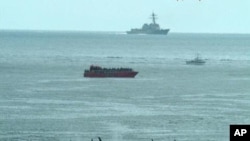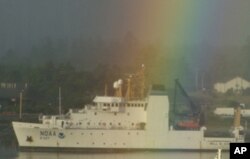Ferries, freighters and fishing and tour boats are part of the tableau that often makes living by the sea postcard-pretty and desirable. But all that maritime activity creates cacophony underwater - and has conservationists and shippers discussing ways to dial that volume down.
Marine scientists at the University of Victoria record sounds through an underwater microphone placed near the shipping lanes off Canada’s Vancouver Island. To them, it almost sounds like the whales are shouting to be heard over the nearly continuous engine noise.
Can you hear me now?
Michael Jasny, senior policy analyst for the Natural Resources Defense Council, says this “fog of noise,” as he calls it, is impeding the ability of whales to communicate.
“Shipping noise falls across the same frequencies that these animals use for all their vital behaviors - for feeding, for finding mates, for avoiding predators and for navigating.”
According to Jasny, sound travels very efficiently underwater and he's not only worried about marine mammals. “The entire web of life in the oceans depends on sound.”
The science in this arena is pretty new. Precise boundaries between noisy and quiet, safe and harmful have yet to be established. But Jasny believes the risks can only rise as international trade and offshore drilling increase.
“As the research has been done, it’s been very clear that what we have on our hands is really a major problem. It’s a serious problem. It’s a global problem. Fortunately, in shipping, we have a problem that has a solution.”
And that solution is quieter ship designs. Nearby in Victoria, Canada, several whale-watch companies brag that their boats produce less underwater racket. Bigger examples are the newest four vessels to join the fleet of the U.S. ocean research agency, NOAA. They’re each 63 meters long.
Quieter ships
Michael Bahtiarian, vice president of Noise Control Engineering, consulted on their design. “These NOAA ships show that you can get fairly quiet - I think quiet enough - because they are able at 11 knots to go up and count a fish and not startle the fish so they can actually count it.”
Bahtiarian points to propellers as the primary source of noise pollution. The fix is to match a more efficient propeller with an optimized hull shape. The new federal research ships also have more expensive engines that reduce vibration.
“People are saying a lot of, ‘Oh boy, here comes something else we have to deal with.’ You know, the technology has been around," he says. "It’s just technology that we’ve had in the military realm for a while.”
Joint effort
Kathy Metcalf, who directs maritime affairs at the Chamber of Shipping of America, says the U.S. shipping industry recognizes the potential noise pollution problem and wants to be part of the solution.
“Our approach is that if we’re progressive now and begin the changeover in the design of ships before we are forced to do it, it will be much less costly to the industry.”
And there’s one more big selling point.
“If people see the fuel savings that we expect to be obtained from this more refined ship design, we don’t think you’re going to have to sell the concept to anybody,” says Metcalf.
She says the best venue for working out any new rules for shipping is a United Nations agency called the International Maritime Organization. She estimates that process could take five years. Eventually, other UN groups may be tapped to control other sources of underwater noise, such as offshore oil and gas production or naval exercises.















